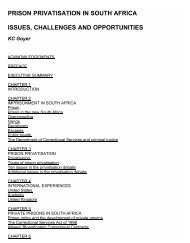S outh A frican Police Service - Institute for Security Studies
S outh A frican Police Service - Institute for Security Studies
S outh A frican Police Service - Institute for Security Studies
You also want an ePaper? Increase the reach of your titles
YUMPU automatically turns print PDFs into web optimized ePapers that Google loves.
The Strategic Plan 2010 to 2014<br />
6<br />
3. SITUATIONAL ANALYSIS<br />
The Situational Analysis provides an overview of the key factors that have influenced the<br />
identification of the SAPS’ strategic priorities and objectives <strong>for</strong> the period 2010 to 2014.<br />
The identification of these key factors has been in<strong>for</strong>med by the legislative mandate of the<br />
SAPS, Government’s key Medium-term Strategic Framework, the priorities of the JCPS<br />
Cluster, the Presidents’ State of the Nation Address - 11 February 2010, issues identified<br />
by the Minster of <strong>Police</strong>, the outcomes of the National Commissioner’s strategic planning<br />
conference with the Department’s top management during September 2009, the President’s<br />
Conversation with the Management of the SAPS and subsequent consultation by the<br />
National Commissioner with management within the SAPS at national and provincial levels.<br />
3.1 Analysis of Crime<br />
3.1.1 All of the prioritized, serious crimes are not equally influenced and cannot be<br />
reduced to the same extent by conventional policing as practiced by the SAPS.<br />
This is why the 7-10% contact crime reduction target implemented by Government<br />
during 2004/2005, <strong>for</strong> implementation over the ten-year period from 2004/2005<br />
to 2013/2014, was never intended to be solely a SAPS or even overall policing<br />
reduction target. The 7-10% contact crime reduction target stated that each category<br />
of contact crime should be reduced by 7-10% per annum over the ten-year period<br />
from 2004/2005 to 2013/2014. The intention was that this national target towards<br />
normalization of crime should be a S<strong>outh</strong> A<strong>frican</strong> ef<strong>for</strong>t involving the CJS, including<br />
the SAPS, all other relevant Government Departments, Non-Governmental<br />
Organisations and the citizens themselves.<br />
3.1.2 The 2008/2009 Annual Report of the SAPS did not in general reflect a particularly<br />
negative crime picture, but un<strong>for</strong>tunately indicated significant increases in the<br />
incidence of the “trio crimes” 1 . Towards the end of 2009, particularly since the<br />
release of the 2008/2009 Annual Report, considerable debate arose as to whether<br />
or not the 7-10% reduction target was realistic. S<strong>outh</strong> Africa can, however, take<br />
com<strong>for</strong>t from the fact that significant progress was made in the reduction of contact<br />
crime since 2004/2005. Contact crime on the whole was reduced by -7,1% annually<br />
during the first four years of the ten-year reduction period, meaning that the overall<br />
target was achieved. In 2008/2009 (the fifth year of targeted reduction) only a<br />
-4,1% reduction was achieved. In the case of attempted murder, common robbery<br />
and common assault, average decreases of -8,4%; -8,2% and -6,9% respectively<br />
were achieved during the first five years of the ten-year period, while assault GBH<br />
decreased by -5,0% per annum. Murder, aggravated robbery and sexual offences<br />
also decreased during the first five years of the targeted reduction, albeit by smaller<br />
margins. Aggravated robbery decreased by -2,7% per annum, while murder and rape<br />
decreased by -2,5% and -2,3% respectively per annum over the first five years.<br />
3.1.3 This means that by the middle of the 7 – 10% ten-year reduction period, three trends,<br />
namely aggravated robbery, murder and sexual offences emerged as the categories<br />
presenting the greatest challenges to the reduction ef<strong>for</strong>t. An analysis of these three<br />
trends indicates the following:<br />
● The difficulty experienced in reducing sexual offences was mainly due to<br />
changes in the legislation relating to these offences which caused rape<br />
1 TRIO crimes include house robbery, business robbery and hijacking

















